January 24th – February 6th, 2008.
This is the fourth study of the Sagharughombe Reef by PCRF.
Platform
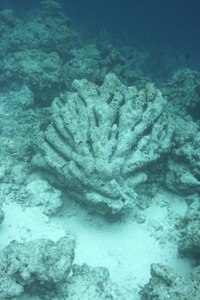 |
| Lobophyllia sp. colony toppled by earthquake |
On 2nd April 2007 at 0739 local time, the northern islands in the Solomon Island chain experienced an earthquake recorded as 8.1 on the Richter scale, followed by a tsunami. The earthquake's epicenter was at 08.481° S, 159.978°E, about 25 nautical miles SSE of Gizo. This point is the subduction zone of the complicated intersection of the Pacific with the Australian, Woodlark and Solomon Sea Plates. The rupture zone extended west for more than 50 nautical miles, and affected large areas of the Western and Choiseul provinces of the Solomon Islands. Thousands were made homeless and 52 people were killed. This was the greatest natural disaster to strike this area.
The damage to the coral reefs of the area was extensive, believed to have been caused more by the earthquake than the tsunami. Branching corals were shattered while boulder corals snapped off at their base and toppled over.
The continental shelf of the volcanic island of Simbo receded more than a metre, Ghizo also receded about a metre, while the fringing reef along the east coast of Ranongga was uplifted more than three metres above sea level and remains completely exposed. Landing at the beaches here has become extremely difficult and fishing possibilities have been drastically reduced due to the reef having been raised out of the water.
There was extensive damage to infrastructure on many islands. Several villages (on Simbo and Gizo islands) were completely wiped out, while others were affected by landslides and other secondary effects. Even with the help of foreign aid, reconstruction of homes and entire villages has only barely begun.
The reef flat of the northwestern tip of the study site rises to 3 meters below the surface, while the reef flat south of the small channel rises up to 1 meter below the surface. For the purposes of our study, we covered both parts of Sagharughombe reef.
Vitareef dives were conducted on sites where Vitareef data were collected in 2006, returned to by use of a handheld GPS. Five transects were repeated at locations documented in 2006, and one transect was conducted in the same area of the reef as the sixth 2006 transect.
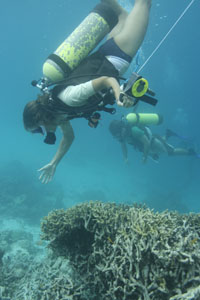 |
| divers on shallow study site |
The average water temperature recorded at the study site was 28.7°C (measurements were taken on an uncalibrated dive computer). The average horizontal visibility at the study site was 85.3 feet (measurements were taken by Secchi disk). The average vertical visibility taken at our nearby anchorage at Mbambanga Island was 56.6 feet.
In 2008, the reef's state of health differed from previous states in 2000 and 2006, during which major bleaching events were occurring throughout the region. This year, bleaching was not seen to be a significant condition affecting the health of the reef. Vitareef data gave a result of 0.6% of corals in the shallow zone suffering from bleaching, and 0.1% of corals in the deep zone.
While crown of thorns have been found in considerable numbers in the past by the local dive operation, Dive Gizo, only three individuals were noted in our two week study. One crown of thorns was sighted on a Vitareef dive, one on a transect site, and another one on the GPS track. However, there was evidence of a larger presence of this coral tissue predator, especially on the reef flat towards the northern tip of the reef, where many small colonies appeared to have been recently attacked by crown of thorns. Napoleon wrasse and moustache triggerfish, predators of the crown of thorns, were sighted on several dives.
In the three previous studies, coral disease was not prevalent although several table Acropora spp. colonies were observed to be suffering from white band disease in 2006. In 2008, the same disease appears to have spread more widely, affecting mostly table Acropora spp. and submassive Porites colonies. Several colonies of massive Porites were found to be afflicted by another ‘white disease’ in which areas of the coral tissue were stark white, separated from healthy living tissue by a highly defined edge.
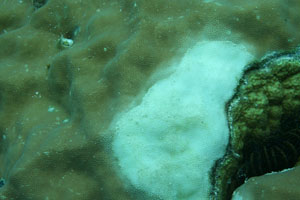 |
 |
| unidentified disease on massive Porites colony | white band disease on table Acropora colony |
Comparison of the analysis of transect imagery between 2006 and 2008 has provided a strong indicator of the extent of the damage caused by the 2007 earthquake/tsunami. In 2006, the shallow zone had a bottom cover of 46.8% living coral in the shallow zone and 26.8% in the deep zone. In 2008, these figures were reduced to 28.1% and 20.2% respectively. There was barely a dead coral recorded in the 2006 transects, whereas in 2008 12.2% of the shallow zone substrate and 6.7% of the deep zone was dead coral. Rock and rubble, much of which could have been produced by the violence on the reef nearly a year ago, accounted for 17.1% of the shallow substrate and 33.3% of the deep substrate, although rock and rubble were also reasonably high in 2006 at 32.9% in the shallow zone and 36.2% in the deep zone.
Massive Lobophyllia spp., table Acropora spp. and weaker foliaceous corals such as Turbinaria and Echinophyllia spp. were greatly affected by the earthquake and tsunami. These corals were in pieces and toppled over, lying sideways or upside down on the reef. Delicate branching and digitate Acropora and Porites species were now in rubble pieces on the sea floor. In general, coral species with wider bases were better able to withstand the earthquake and tsunami without breaking off from the substrate while those with a narrow point of fixation to the substrate tended to be shaken from their foundation and toppled.
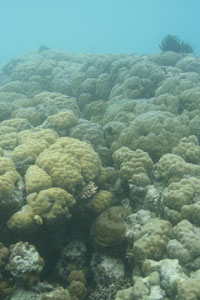 |
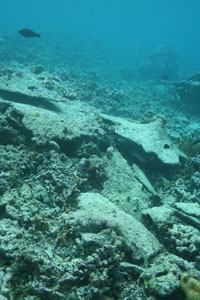 |
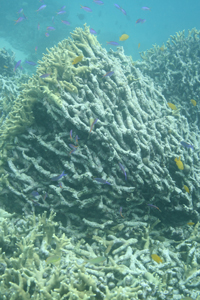 |
| massive Porites on the reef crest braced each other during earthquake |
damage around the channel marker on the northern end of the reef |
Porites fingers colonies on the reef slope |
In one area of the reef slope, on both sides of a sandy channel Porites spp. finger corals were particularly severely affected. In many cases, whole colonies were dead, leaving only the coral skeleton. These recently dead colonies are represented by code 15 in the Vitareef system, with 15.1% of colonies of all genera in the shallow zone ascribed this code and 16.0% in the deep zone. In some cases, the ends of the fingers were still alive, fighting off the encroaching algae smothering the dead skeleton. Coral colonies on the reef slope were more protected and fared better than those on the reef flat. Sandy areas on the reef resembled underwater landslides.
The only entirely unaffected areas of reef were where Porites spp. boulders braced each other tightly from the impact close to the reef top.
Since the earthquake, encrusting coral species have been able to prosper as they are better adapted to settle and cover newly formed substrate. Branching coral species were also seen in small, newly recruited colonies. Coralline algae and Halimeda macroalgae were both significant on the reef. Vitareef showed 2.7% of coral colonies in the shallow zone to be overgrown by macroalgae, and 3.4% in the deep zone. A low population of herbivorous invertebrates was found on the reef, increasing the threat of overgrowth by filamentous algae. Edge damage was noted on massive Diploastrea heliopora and Porites spp. colonies, although in general it appeared that Diploastrea heliopora colonies were well equipped to survive the earthquake and tsunami. However, edge damage was recorded on 13.5% of colonies in the shallow zone and 13.0% of colonies in the deep zone.
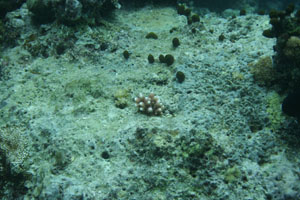 |
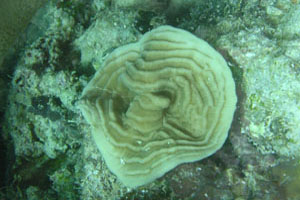 |
| a very new Acropora recruit | a young Pachyseris sp. colony |
 |
| Napoleon wrasse |
Despite the calamitous earthquake and tsunami event in April 2007, fish life on Sagharughombe reef remains abundant and diverse. Most of the typical reef dwelling fish, such as the damselfish, angelfish, wrasses, and parrotfish, are still seen swimming around the coral rubble and remaining coral bommies. However, the average size of fish seems to be decreasing since the 2006 study. Another difference from 2006 is that the great schools of trevallies, Caranx spp., that were once abundant are now almost absent, although some individuals were seen cruising around the reef.
Local informants blame the aftereffects of the tsunami as the major cause of fish decline in the region. It has been postulated that the tsunami destroyed much of the land based food reserves on most islands. Not only has this ruined the gardens of local communities, but the effects of the tsunami have decreased local market supply of food and caused drastic price rises. This socio-economic problem has probably caused many local villagers to rely on ocean based food supplies. The increased fishing pressures resulting from the tsunami may explain the absence of trevallies, Caranx spp., and the decreased size of other fish species in the region.
On the transects, the mean species richness for the six transect studies is 81.2 species and the mean number of fish observed on the transects is 1078.5 fish. Two sharks (one Triaenodon obesus and one Carcharhinus melanopterus) were observed on the reef during the study period although none were present on the transects. Also, a few resident Napoleon wrasse (Cheilinus undulates) were observed on the reef just outside the transect zone. The moustache triggerfish (Balistapus viridescens), also known as the titan triggerfish, were very territorial suggesting that they were in the midst of their reproductive season.
Interestingly, there was an abundance of baitfish seen running around the reef. Schools of rainbow runner and even some tuna were observed chasing the bait. The abundance of baitfish in the region is probably due to seasonal cycles.
Throughout the study site there was an abundance of Christmas tree worms, Spirobranchus giganteus. These were found in both deep and shallow areas of the reef and were often found on Porites heads. Along with the Christmas tree worms there were also bioeroding scallops, Pedum spondyloideum, found throughout the study site.
Sea urchins were noted on the reef in small quantities. There were, however, more urchins found in the deep sections of the reefs than the shallow. The sea star Formia spp. was prevalent along the reef study site.
There was a marked absence of any sea cucumbers on the reef. There were no sea cucumbers (Beche-de-mer) found during transects on the reef. This absence leads us to conclude that overfishing is a continuing problem in this area, as has been noted in previous studies. A moratorium took effect in the month of February 2008, stopping the harvesting of sea cucumbers. This will hopefully lead to an increase of their numbers in the future. Some good news for the sea cucumbers can be found on the reefs off the World Fish Center. The World Fish Center has a clam farm that has been culturing giant clams. When snorkeling in this area, a variety of sea cucumbers were noted. Their presence here is most likely due to a lack of fishing pressure on the reef and provides hope for other populations in the area.
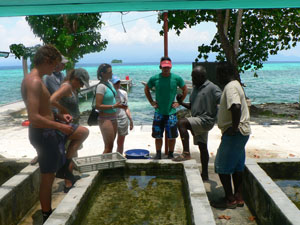 |
| visit to the World Fish Centre |
The main focus of the World Fish Center is farming Giant Clams. There were giant clams noted throughout the study site on Sagharughombe; the species Tridacna squamosa was most prevalent.
Two other species notably absent from the reef were the trochus, Tectus niloticus, and turbinaria snails. These snails are collected in this area for sale of their shells. Only one trochus snail was noted during transect dives on the study site. This snail was found in the shallow section of the reef. This is another species that is possibly being negatively affected by over fishing. They are important herbivores and their absence on the reef could lead to problems with overgrowth of algae.
There were a good number of tunicates found on the reef. The species Atriolum robustum was most common, followed by the solitary tunicate, Polycarpa aurata.
Also of note, encrusting sponges were common along all of the transects and were the most common sponges seen. The elephant’s ear sponges, a flagship invertebrate for this particular reef, were in reasonably good health and there were several particularly fine vase sponges.
In general there was an unevenness of invertebrates on the transects, some had large numbers of invertebrates while others had very few.
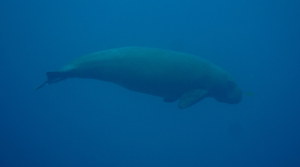 |
| dugong photographed on the study site |
Dolphins were not as abundant in the Gizo region this year, in comparison to previous years. Only three dolphin sightings were recorded during the study period: ne dolphin was heard blowing at the surface near the side of the ship at night; while en route to a Vitareef dive site, three spinner dolphins were spotted jumping in sight of the small boat; one morning, fifteen small spinner dolphins were sighted jumping and possibly feeding 100 yards off the stern of the ship.
There were two separate sightings of a dugong – one on the strip reef lying between the study site and the ship’s anchorage, the other on the study site itself.
Only one hawksbill turtle was seen at Sagharughombe reef. The turtle was observed during the course of an Immersive Media video dive. It was slowly moving away and uninterested in the diver and snorkelers in the water.
This reef has been studied by PCRF since 2000, with this study in 2008 being the fourth complete data set taken at the site. Between 2000 and 2006, we have observed a slow decline over time in both health of the substrate and fish populations. This is due to several factors including bleaching events in 2000 and 2006 and sedimentation from the logging stations in Kolumbanggara across the Blackett Straits. The hefty impact of the 2007 earthquake and following tsunami created severe damage, but to an already weakened system.
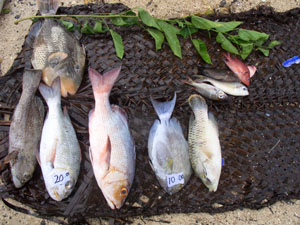 |
| juvenile Napoleon wrasse (on right) for sale in Gizo market |
There are economical, ecological, and physical impacts of increased fishing pressure on the reef and other reefs in the surrounding area. This has been an issue for many years now. Back in 2000, while the Solomon Islands was in a particularly unstable political phase with a coup in Honiara, the local economy plummeted, driving many to fishing for an income and therefore over-exploiting the reef resources. Much of the cash required in these islands is to cover very high school fees. Fish Attraction Devices (FADs) have been established in the last few years off Simbo Island to alleviate the fishing pressure from the reef. The Kennedys from local dive shop, Dive Gizo, are in the process of creating several marine reserves as no take zones at Sagharughombe reef and other damaged reefs nearby. But the current level of pressure on the reefs has only been exacerbated now by the lack of distribution of funding for recovery from the earthquake and tsunami. Entire villages have been destroyed, many are homeless and still camping in tents almost a year after these events. Building materials are required for reconstruction and again, the reefs are suffering because of a need for hard cash.
All harvestable species are under threat. Sea cucumbers have been almost completely removed from the ecosystem, along with several other commercially useful invertebrate species. The fish populations are still significant, although the repeated sighting of young Napoleon wrasse in the market is a worrying sign. And with the severe changes in substrate, the fish populations may suffer in the short term future from several angles.
In terms of substrate, the effects of the earthquake on the living coral cover have been significant - not just on this reef, but on most reef systems in the area. There are intiatives under discussion to encourage recruitment on certain key reefs. However, the current picture underwater is rather bleak. Hopefully, over time new coral colonies will take hold of the substrate which is thankfully covered mostly in coralline algae, a suitable bottom cover for settlement of coral larvae.
The results of our consecutive studies will be presented this July at the International Coral Reef Symposium in Florida, USA.
Hamiton, R., Ramohia, P., Hughes, A., Siota, C., Kere, N., Giningele, M., Kereseka, J., Taniveke, F., Tanito, N., Atu, W. and L. Tanavalu, 2007. Post-Tsunami Assessment of Zinoa Marine Conservation Area, South Choiseul, Solomon Islands. TNC Pacific Island Countries Report No. 4/07
Jackson Kelly, MGG Student Participates in Solomon Islands Tsuanmi Survey, Soundings, Rosenstiel School of Marine and Atmospheric Science, University of Miami, September 2007
McAdoo BG, Jackson KL, Kruger J, Bonte-Grapentin M, Moore A, Rafiau WB, Billy D, Tiano B, Geologic Survey of the 2 April 2007 Solomon Islands Earthquake and Tsunami
 |
| Reef uplifted by earthquake at Ranongga |